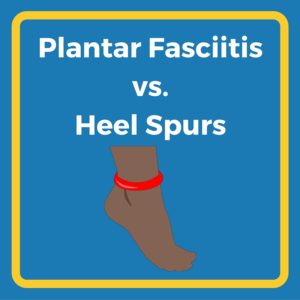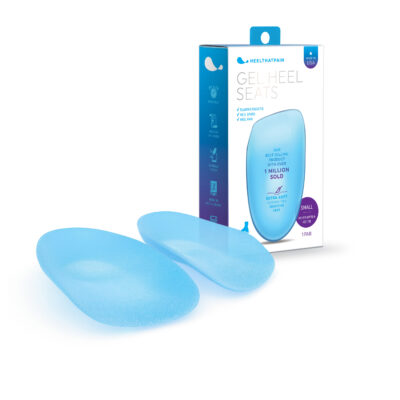 Plantar fasciitis and heel spurs are two different but closely connected conditions that lead to chronic or intermittent pain in your feet and heels.
Plantar fasciitis and heel spurs are two different but closely connected conditions that lead to chronic or intermittent pain in your feet and heels.
Knowing the difference between the two, and also how they’re related to one another, can help you determine which one you’re suffering from, set a course for treatment, and reduce symptoms of pain and discomfort.
Knowledge is power when it comes to managing, treating and beating your heel and foot pain.
Keep reading below to arm yourself with knowledge and get back on your feet–comfortably!
What’s the Difference Between Heel Spurs and Plantar Fasciitis?
The main difference between plantar fasciitis and heel spurs lies in the source of the pain. Pain from plantar fasciitis is typically felt in the arch of the foot and the heel due to damage or overuse of the plantar fascia. Heel spurs, or tiny jagged calcium deposits on the heel bone, develop in response to the trauma to the plantar fascia and are localized to the heel.

Causes of Heel Spurs vs. Plantar Fasciitis
Think of heel spurs and plantar fasciitis as a one-two punch. Plantar fasciitis is caused by stress and damage to the plantar fascia ligament, the area between the ball of your foot and the heel on the underside of your foot. This stress can be caused by carrying extra weight, wearing worn or unsupportive footwear, trauma to the foot, or spending an excessive amount of time on your feet.
Heel spurs develop as a secondary result of plantar fasciitis. When the plantar fascia ligament is damaged, the body creates what’s known as heel spurs–small, sharp calcium deposits on the heel bone–in an attempt to support the damaged fascia. Unfortunately, if left untreated, heel spurs can further damage and erode the fatty pad that supports your heel and do permanent damage to your foot.
Symptoms of Heel Spurs vs. Plantar Fasciitis
The simplest way to describe heel spurs is a stabbing sensation in your heel(s)–which makes sense, because that’s exactly what happens. The sharp calcium deposits building up on your heel bone are literally stabbing into the fatty pad of your heel. You’ll likely notice that the pain is worst first thing in the morning, and can come and go throughout the day.
Plantar fasciitis on the other hand encompasses a broader range of symptoms localized in the foot and heel area. Symptoms of plantar fasciitis may be present for some time before you feel the stabbing sensation of heel spurs, since untreated plantar fasciitis and a strained or damaged fascia are the primary causes of heel spurs.
Symptoms of plantar fasciitis include redness, swelling and inflammation in the heel and fascia (the area between the ball of your foot and your heel). You’ll likely experience sharp pain that’s worse in the morning and may get better as the fascia are stretched throughout the day. An aching, burning pain in the heel is the hallmark of plantar fasciitis.
Treatments for Heel Spurs vs. Plantar Fasciitis
Treating plantar fasciitis (which can lead to heel spurs if left untreated) quickly is key to avoiding additional damage. Give your feet rest breaks during the day if you’re spending a lot of time on your feet, and dial down the exercise routine if necessary. It’s also important to ice your feet to reduce inflammation (these Ice Pack Therapy Slippers strap onto the foot and stay in place with velcro, giving you targeted relief for inflammation).
For both plantar fasciitis and heel spurs, it’s critical to wear shoes that have a thick cushioned sole and aren’t worn out at the heel. It’s also important to maintain a healthy weight to avoid adding additional strain to the plantar fascia and heel. One of the best ways you can treat both plantar fasciitis and heel spurs is to use affordable orthotic inserts. They’re effective in greatly reducing or eliminating pain for 90 percent of customers, they only cost about the same amount as a lunch out on the town, and are a great alternative to costly, heavy orthotic shoes or more drastic (and typically unnecessary) surgery. Heel spurs and plantar fasciitis can sound intimidating–and feel even worse. But with a few ounces of prevention and consistent, proven remedies, you’ll be feeling better in no time.
Other Comparisons Articles
| Plantar Fasciitis vs. Stress Fracture | Plantar Fasciitis vs. Tendonitis | Morton’s Neuroma vs. Metatarsalgia |




How do I order “Your Guide for Plantar Fasciitis”?
Hi Marilyn! You can leave your contact info here and we will email it to you shortly
Good stuff. I have deposits in my arch and my upper foot 2 on my big toe . 5 deposits on my right, 4on my left foot. I need help.
Kevin, I have suffered from plantar fasciitis and heel Spurs plus been diagnosed with RA I have had plantar release surgery and also removed a damaged nerve that turned out not to be damaged it was RA Which is commonly mistaken for damaged nerve. None of this has helped I’ve also been thru 4 months of therapy and multiple painful shots. I also have multiple spurs 4 on one foot 5 on the other. I was at the point of not being able to wAlk and I have to lease out my store which was my only source of income and became very depressed. After a little over 3 years and 4 different Dr’s I have some relief from heel that pain shoe inserts , plus a flat steel insert from dr to keep my toes from bending so much and and prednisone pack This is the best I’ve felt in over : years. I still have s little pain but nothing unbearable like I did have. I also do my stretched daily. Hope this helps you
I’ve been having horrible foot pain. Right in front of the heel of my foot that radiates to the bottom/middle arch. I’ve been searching the internet for reason why and came across your post. I know it’s several years old. We’re you ever able to find comfort or a solution. I have extremely high arches. They’ve been that way since I was a young child and studied ballet. I work in retail and am on my feet for about 9 hours a day. I’m also overweight but I recently had gastric sleeve surgery and have lost 35 pounds. After my son was born three years ago I really let myself go. My typical weight before my son was around 120. While pregnant & afterbirth I piled on the pounds. I got up to 263😱I have been excersing a lot
More lately and am continuing to lose weight at an impressive weight. Even though I’ve lost 35 pounds that pain has not gotten any better. I think it’s time to visit a podiatrist because I’ve tried everything. Some days it bothers me terribly and others not so much. Something is definitely wrong though. I wish you all the best and hope you were able to find a solution that eased the pain. If so can you let me know what worked. I’m desperate at this point. The pain is starting to become unbearable. Thanks for listening to my rant!
Kevin, I have suffered from plantar fasciitis and heel Spurs plus been diagnosed with RA I have had plantar release surgery and also removed a damaged nerve that turned out not to be damaged it was RA Which is commonly mistaken for damaged nerve. None of this has helped I’ve also been thru 4 months of therapy and multiple painful shots. I also have multiple spurs 4 on one foot 5 on the other. I was at the point of not being able to wAlk and I have to lease out my store which was my only source of income and became very depressed. After a little over 3 years and 4 different Dr’s I have some relief from heel that pain shoe inserts , plus a flat steel insert from dr to keep my toes from bending so much and and prednisone pack This is the best I’ve felt in over : years. I still have s little pain but nothing unbearable like I did have. I also do my stretched daily. Hope this helps you
I have been wearing yout heel seats in all of my shoes after the dr. told me I had plantar fasciitis . I got instant relief as soon as I started wearing them ! Been using them for two years and when I don’t use them, I can feel the pain of the plantar fasciitis. So, I am so grateful to Heel That Pain.
Its that true? Cause i got the terapy with the ultra sound, and thats dont effect
Can you send me more info for your foot inserts
Hi Alicia,
You’ll find tons of info on our Heel Seats here: https://heelthatpain.com/treatments/htp-heel-seats/
Hope this helps!
Please send info on insert
Hi Anne, You can find out more about our inserts here: https://heelthatpain.com/treatments/htp-heel-seats/
If you still have questions, please call us at 877-215-3200
I have been using Dr Scholls inserts for plantar fasciitis and they help the heel pain but they cause my arch’s to ache which doesn’t seem right to me. I have had flat feet since birth and now that I’m in my 60’s, the heel pain has really started getting worse. Will the Heal Seats also cause the aching in my arch’s? I’d like to get your thoughts before I order. Thanks!
Hi Peggy! Heel Seats should help relieve pain in the heel, and they provide the appropriate support for flat feet. They will realign the arch of your foot so that the impact of walking and running is better distributed. They can take a couple weeks to get used to, but I know you’ll love them 😀
is there anything that you can wear in sandles?i have the earth sandles that have a little custion but I think I need something more? thanks
I do not have pain in arch portion of the foot. On x Ray it is found that I do have spur in heel bone. It pains a lot particularly in the side bone of inside portion of heel ( big toe side of heel ) . I now wear Brooks Classic Walking Shoe but I find it heavy. Please let me know
1. Shoes for planter fasciitis and pain due to heel spur are same?
2. Suggest 5 best shoes for spur pain along with its weight.
3. Which is light weight shoes in heel pain category. I mean more cushions yet not heavy.